|
Bangor Lot 03
(there are so many Bangor lots I'm running out of unique names)
postcards, photos etc. no specific family name
Bangor Lot 3 page ONE
Bangor Lot 3 Page TWO
Servants Wages - Mountstewart


Servants Wages - From the Army & Navy Co-Operative Society Limited, 105
Victoria Street, Westminster, S.W.






1
2
3
4
5
6
1) Mountstewart, Newtownards - Amy N. McClintock, April '94
2) Sarah Murray - Cook - £20 yearly - June '93; Margaret Forbes - house
servant - £16 quarterly - 6th Dec. '93/23rd June '94
Jane Cooke - laundress - Oct. '93; Lizzie McFarland - kitchen maid - £10
quarterly - 10th Aug. '93/9th June '94
Sarah Waugh - housemaid - £16 quarterly - 30th June 94; Sarah Smiley -
kitchen maid - £12 quarterly - Aug. '94/Oct. '94
Lizzie Geoffrey - kitchen maid - £9 quarterly - Nov. '94/Dec. '94; Mary Drew
- 2nd housemaid - £14 quarterly - 28th Feb. '95/1st July '96
Annie Elliott - kitchen maid - £11 quarterly - 14 weeks; L. Kemp - 2nd
housemaid - £14 quarterly - 5th Aug. '95/17th Nov. '95
M. Smiley - kitchen maid - £12 quarterly - 10th Aug. '95/8th Jan. '96; G.
Hargreaves - Upp. housemaid - £16 quarterly - 1st Sept. '95/17th Nov. '95
L. Hughes - Upp. housemaid - £22 quarterly - Nov. '95/Jan. '96; Mary Pollock
- Upp. housemaid - £16 quarterly - Jan. '96/May
M. Daly - under housemaid - £14 quarterly - June? '95/5th Sept. '96; G. Daly
- under housemaid - £12 - June 9th '96/5th Sept. '96
M. Ross - kitchen maid - £12 quarterly; K. French - kitchen maid - £12 - 2½
months - £2-10; M. A. McGovern kitchen maid - £8
Sarah Mallon - housemaid - £16
3) Sarah Murray - Cook - £20 - June '94 - June '93
4) Sarah Waugh - 1st housemaid - £16 - 30th Dec. '94 £8 29th Jan. '95 - 30th
June '94/2nd Sept. '95
Ellen Hargreaves - upper housemaid - £16 1st Dec. - 1st Sept. '95/17th Nov.
'95
G. Hughes - 1st housemaid - £22 - Nov. '95/Jan. '96; Mary Pollock - single
house? - £16
5) Jane Cook - laundress - £22 1st Jan. '95 - Oct. '95 (last payment date
1st July '97)
6) Mary Drew - 2nd housemaid - £14 28th June - 28th Feb. '95/1st July '95;
L. Kemp - 2nd housemaid - £14 5th Nov. - 5th Aug. 1895/17th Nov. 1895
Margt. Daly - 2nd housemaid - £14 - Nov. '95/Sept. 5th '96; Essie Daly - 2nd
housemaid - £12 - June 9th '95/ Sept. 5th '96; Mary Beacom - 1st housemaid -
£16 - Sept.






1
2
3
4
5
6
1) M. Smiley - kitchen maid - £12 10th Nov. - 10th Aug. '95/9th Jan. '96;
Mary Ross - kitchen maid - £12 - Jan. '96
Kate French - £12 - 2½ months - £2-10; Mary Anne McGovern - £8; Sarah Mallon
- £16 - including railway fare 5 months paid - Dec. May
2) Barney McLaughlin - Groom - £41-12 per year 1936/1937 - Has a cottage in
the village rent free, potatoes, turf, 1 quart of milk per day, National
Health Insurance free at 1'/8" per week.
3) Andy McHugh - gardener - £41-12 per year 1936/1937 - Has a cottage in the
village rent free, potatoes, turf, 1 pint of milk per day. National Health
Insurance Free at 10" per week
4) Henry Bell - labourer - £41-12 per year 1936/1937 - Has a cottage rent
free, potatoes, turf, 1 pint of milk per day. National Health Insurance
free. Half National Unemployment (4½)?
5) John Montgomery - labourer - £41-12 per year 7/11/36 to 16/1/37 - Has a
cottage rent free, potatoes, turf, 1 pint milk per day. National Health
Insurance free. Half National Unemployment (4½) - Given temporary notice as
from 16/1/37
6) William Condy - labourer - £39 per year 1936/1937 - Has a cottage rent
free, potatoes, turf, 1 pint of milk per day. National Health Insurance
Free. Half National unemployment (4½) - Given temporary notice as from
16/1/37






1
2
3
4
5
6
1) Thomas Bell - Hall Boy - £20-16 per year 1936/1937 - Lives at home, has 1
pint of milk per day. National Health Insurance Free
2) Tessa McKirnan? McKinnan? - cook - £36 per year - Has National Health
Insurance Free
3) Anna McHugh - housemaid - £28 per year 1937 - Has National Health
Insurance Free
4) Kathleen McHugh - parlour maid - £24 per year 1937 - Has National Health
Insurance Free
5) Elizabeth Doyle - nurse? - £65? per year - 18/1/37
6) McCausland - £26 per year 14th Dec. 1936- 7/2/37






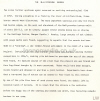

"Naturescape" Tales of the Riverbank by Ronnie Russell - Part One
Almost everyone knows the old stone bridge at Ballyholme, with its little
"window" through which generations of children have peered. This point
is the outfall of the largest of North Down's streams, known as "Ballyholme
River", Ballycrochan River" or "Cottown River" depending on which townland
you are in! Rising in the townland of Drumhirk, north-east of Newtownards,
it flows through the Six Road Ends and then makes a 90 degree turn
northwards to head for the sea via Ballycrochan and Ballyholme. This article
is an attempt to bring together various aspects of the river's history,
environment, flora and fauna, with the flow providing a link through it all,
from Stone Age settlements to grandiose 1980's villas.
ARCHAEOLOGY
Today the river is largely neglected, or at best taken for granted, by the
urban residents of the banks, while to the farmers it is of some importance
as a field drain. However, the settlements of our ancestors needed nearly
fresh water vitally, and several intriguing archaeological finds have been
made close to the river. Ballyholme is famous today as the main
bathing beach of the town, but the area has changed dramatically through the
centuries. Between high and low watermark a layer of submerged peat between
four and six inches deep, resting on a loose shingle of boulder clay, has
been recorded. It is interesting to note that this layer contains the
upright stumps of Scotch fir and various other species of trees.
OLD CLIFF
Behind the main expanse of beach, where the present sea wall is, was a
raised beach. This overhanging cliff was comprised of sand and gravel
reaching a height of 20 feet. It was in this sheer face that the smallest of
the swallows, the sand martins, came each summer to hollow out their nesting
sites, a habit from which they take the name. A two-three foot long
horizontal tunnel is scraped into the sand bank culminating in a larger
nesting chamber which is then lined with feathers.
THE VIKING GRAVE
In the 1890's the sandhills above the east bank of the river mouth were
being levelled for building purposes when a great array of worked flints and
arrow heads were found. Not uncommon, these Stone Age artifacts were
overshadowed by the discovery of a Viking grave! As was customary, some
possessions had been interred and these items, "tortoise" brooches and a
bronze bowl, are now in the National Museum, Dublin, to which they were sent
by Mr. Seaton F. Milligan, whose small son Charles (later Mayor of Bangor n
1960's) first chanced upon the find. One can only speculate as to the
circumstances of the burial, which is dated ninth or tenth century, but it
is probable that Ballyholme Bay, with its flat sands for landing and the
good water of the stream, was an ideal haven for marauding Vikings.
A NORMAN FARM
Moving inland half a mile or so to the riverbank at Riverside Road, many
discoveries were made in 1968 during excavations to level a new garden.
Besides more worked flints, a beautifully shaped and polished stone axe was
found, these and other items being dated Early Bronze Age (1200 - 1400 B.C.)
More intriguing still, a large array of 13th century objects were uncovered
- horse shoes, a plough shoe, nails, pottery fragments etc. - and
archaeologists concluded that the midden of a well-to-do Anglo-Norman
farmhouse had been revealed, possibly a "grange" which supplied
the Abbey. Some of the glazed pottery was believed to be French in origin. A
full account of this story appears in "The Journal of Bangor Historical
Society - Volume II".
THE LINEAR PARK
As you proceed along the river from this point to the south side of the
ringroad you will find the town's newest park. The Linear Park was developed
in 1984 from a wasteland dump (fields prior to the housing schemes) by North
Down Borough Council as an amenity for the residents of the Ballycrochan
area. An extensive programme of tree planting was carried out with many
species including willow, poplar, alder, maple and whitebeam, whilst the
sides were adorned with the attractive deciduous shrub with the unflattering
name of dogwood. The most interesting management is however along the
river itself. At a number of points along its course small bays were cut
into the bank. Across the entrance of each were placed boulders in order to
cut down the flow of the river and thereby create areas of still water. Into
each bay were planted bullrushes and reeds. Although the plants initially
took hold, the effect of the last two winters has taken its toll, but this
is a matter which can be remedied. One final point before leaving the park
is to deplore the senseless vandalism to the trees. This year alone over 200
trees have had to be replanted.
THE BALLYCROCHAN SWORDS
Two miles farther upstream again occurred an exciting archaeological find in
1949. During ploughing in a field by the river at Ashfield Farm, three
bronze swords were discovered. Two were imperfect castings and only the
third had beaten edges, so the work and standards of the Ballycrochan
bronze-smith of about 500 B.C. can be clearly judged (these swords being now
on display in the Heritage Centre, Bangor Castle.) Nearby, large amounts of
oak timbers with gouge marks were found, suggesting to experts that the
swords had been made in a "crannog", a dry timber-fenced settlement in the
midst of a lake or bogland. Certainly in the 17th century this area was
marshy. During further excavations in 1954/5, cooking pits believed to
pre-date the era of the swords were found. An earlier course of the river
than the present one was traced and four log-lined troughs by it were
uncovered. Water would have been brought, stones hearted and dropped in and
then a joint boiled. Experiments have shown that a ten-pound leg of mutton
can be cooked in four hours by this method! By one of the pits five
tons of used stones were found, the debris left by seasonal bands of
hunters. It is known that the climate a few centuries before the boggy era
of the crannog and swords was drier, thus favouring nomadic hunters in our
area.
LITTER LIFT
Shortly there is to be a "litter lift" organised by the Conservation
Volunteers in the new Linear Park, watch the "Spectator" for more details!
This body also welcomes any unemployed person to their midweek groups each
Tuesday and Thursday at Clandeboye Estate (where the old orchard is being
transformed). On Sunday 13th April a working party will be meeting at 10.15
for the tasks at Orlock Point. ... to be continued
next week. (below)







"NATURESCAPE" by Ronnie Russell Tales of the Riverbank - Part Two
Stone Age man, the Bronze Age hunters and sword-makers and the Anglo-Norman
farmers all needed the Ballyholme/Ballycrochan river as an intimate part of
their existence/ Moving on a few centuries, new generations exploited it for
personal gain. A 'Myll' is marked on Thomas Raven's map of 1625 (now in the
Heritage Centre, Bangor Castle). It was situated on the site of the present
Millbank House (east side of Ballycrochan Road) and the stream was dammed
for control of the power, During the eighteenth century much of the
marshland mentioned before in Ballycrochan and Cottown townlands was drained
and the flow of the stream channelled into its present course there. Around
this period more mills came into use and a huge dam was created on the
former bog area to the south of Hawe Road, Ballycrochan, still remembered by
the name of the adjoining Dam. Road. This shallow lake, 600 yards wide,
covered the spot where the Ballycrochan swords were still lying buried! A
sluice by Hawe Road controlled the flow, and between here and Ballyholme
beach no fewer than five miles are marked on the Ordnance survey map of
1858.
INDUSTRIAL ARCHAEOLOGY
At Millbank, a corn mill and a flax mill are shows on this map, while a
short distance downstream, adjacent to the present Pinehill Park, was
another flax mill. An 'Old Corn Mill' is marked on the south side of the
High Donaghadee Road, where the back gardens of Cherrymount Park slope down
to the river, while on the other side of the main road was a crescent-shaped
dam below the present Riverside Road. This helped work at the watermill in
the valley where now stands Fruithill Park i.e. below the windmill on
Windmill Road. In 1835, one James White owned both mills, having enough
water for the watermill eight months of the year. The remains of this
watermill were only very recently demolished.
THE DRAINED LANDS
The huge dam to the south of Hawe Road was drained in 1865 and the land
reclaimed, joining the neighbouring drained bogland through which the river
flows. Here we return to an agricultural setting and the associated
wildlife. At this time of year there are a large number of mallard
pairs. The most common and familiar of our "dabbling" or surface-feeding
ducks, the mallard of Ballycrochan have a distinctly different regard for
man than their cousins in Ward Park! On approaching, they will rise rapidly
and without difficulty form (from) the water, making a fast escape. Though
feeding on the river on tiny plant and animal matter, and larger seeds,
their nests are in thick vegetation nearby. In good seasons the clutch can
be up to twelve eggs, which only the female incubates, the make taking no
part whatsoever in this process.
THE MAJESTIC HERON
Also to be seen feeding in the river is the Grey Heron. This majestic
guardian of the marshes will patiently stand motionless for considerable
periods beside or in the water in wait for a fish or some other small
creature to come by. Then, with a rapid dart, the prey will be pierced
by the strong bill. In days of old anglers believed that the birds secreted
oils from their legs and feet which attracted fish towards them, and
consequently used to rub the fat from the bird onto their bait - an
unnecessary exercise! The geography of this area has changed little
since the draining of the dam. The fields are still basically the same size
and shape as they were over a century ago, and standing on the disused
railway bridge (once carrying the Belfast - Donaghadee branch line) at
Cottown bridge, one gets almost the same view as the rail passengers of the
late nineteenth century.
DELIGHTFUL LAPWING'S
Seen feeding in the fields are flocks of lapwings, or peewits as they are
sometimes known. In the past lapwing eggs were commonly served as "Plover
Eggs". These birds are a delight to watch on the wing. The flock will appear
to rise on one, lifting high into the sky and after impressive aerial
displays will then tumble down. Drainage in this area is still
continuing and along with peat and rushes large amounts of bog timber are
being dredged up. There is a reference to Ballycrochan bog timber being used
to repair the boards in the Wards' Bangor mansion in the eighteenth century.
Whether or not this was ideal material is somewhat open to conjecture. The
possible reason could have been due to the timber shortage of the time, and
that during that time it was illegal to make or sell any articles made from
oak.
BALLYHOLME BRIDGE
A moment's thought will make one wonder why such a substantial bridge exists
over the mouth of the river when there is no apparent need for it! The old
road from Bangor to Groomsport and Donaghadee (pre about 1850) ran along the
shores of Ballyholme Bay and therefore a sizeable bridge was needed.
RECENT DEVELOPMENTS
In studying both the archaeology and industrial archaeology of the river, it
becomes obvious that this is the first century which has no real need for
the river for life, food or prosperity. It is still sad, though, to see the
river fouled and abused (in a way Stone Age man could not have tolerated) as
it runs through ostensibly affluent new areas. Perhaps the fault lies partly
with the insensitive developers who design houses with no concessions to
traditional styles and name Co. Down avenue after "posh" london districts.
All that results is a glaring lack of a sense of place of a community with
roots, so it is scarcely surprising that litter and vandalism are bred.
However local schools and conservation groups are becoming more and more
active trying to educate people to the need to be sensitive to our
irreplaceable natural heritage.
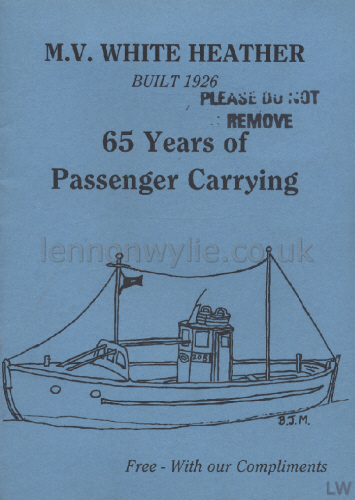










M.V. White Heather Built 1926
65 Years of Carrying Passengers
Hello, It is hoped you'll find this brochure interesting. We have drawn
information from the memories of working boatmen, and local people to form a
short history of the White Heather. We would like to thank the
advertisers for their support and goodwill. It is hoped the readers will
support them during the summer season. Many thanks, Brian James Meharg











 

To Aggie from George with best wishes Sept. 6th 1903
faint writing - from ? Park, Bangor info at back
Newspaper Clipping inside book - Our Poets' Corner & Our Local and District
News
Head-Constable Smith, Newtownards, is now on leave of absence, and his
duties are being efficiently discharged by Sergeant Finnigan. - Dr. Cromie,
of Clough, the registrar of deaths for the district of Castlewellan, has
reported the death of a woman named Sarah Rooney, aged 105 years. - In the
first stage for the Albert Prize at Bisley Rifle Meeting, Mr. W. S.
Johnston, J.P., Newtownards, took honours with the good score of 94 points,
out of a possible 105. - Sailing Race, To-day (Saturday), at three o'clock,
there will be a sailing competition on Strangford Lough, confined to local
boats, for which three prizes are offered. The start will be made from
Anderson's Bank. - We understand that on Wednesday a memorial from
Newtownards was forwarded to the Local Government Board requesting that
effect should be given to the vote of the Guardians appointing ? Hugh C.
Finlay to the Mastership of the Workhouse. - The public will be gratified to
learn that Sergeant Shanley, who has been in Downpatrick infirmary for some
time with a severe illness, has now so far recovered that in a few days he
will be able to resume his duties in Newtownards, where he is much
respected. - First Examination in Medicine, Among those who successfully
passed at the examination lately held in Dublin we notice the name of Mr.
Robert Gaw Kelly, son of Mr. Samuel C. Kelly, T.C., of this town. We trust
that this is only the beginning of future successes. part article... The
directors of the Belfast and County Down Railway on Wednesday made their
annual inspection of the stations on the line, including Newtownards, which
is under the control of Mr. .....
      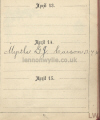  
January 19, Ruby Johnston ~ February 10th, M. Smith 1919, Shore Street,
Holywood ~ March 29th, E. Coates ~ April 5th, Wm. C. Mercer, 1906; April
6th, B. McIlroy, 1925 ~ April 7th, George P. Carson 1910 ~ April 11th,
George Carson 1903 ~ April 14th, Myrtle G. J. Carson 12-7-20 ~ April 19th,
Gertrude L. Elliott 1906 ~ May 2nd, A. Weir 1906
        
May 10th, William Weir 1906 ~ May 22nd, C. McConkey; May 24th, A. Miller
1903, J. Gordon 1906 ~ August 5th, Carri? E. Cleland ~ August 19th, Joseph
Hodgins, Holywood ~ September 6th, A. Pettigrew 1903 ~ September 22nd,
Lizzie Carson; September 23rd, W. J. P. McConkey/Corkey ~ September 27th,
Maggie McCready 1903 ~ September 29th, T. J. McConkey
      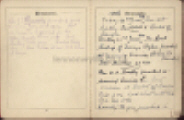 
October 1st, L. Maginnis ~ October 20th, J. Stanford P. Carson 1911 ~
October 28th, Wm. Elliott ~ November 12th, Annie S. McCrea, Pettigo ~
November 19th, 72 (age maybe) F. McConkey 1903 ~ November 22nd, Andrew
Holmes Provan '06 ~ November 28th, Dorothy Cleland 12.7.20
Memoranda: Rev. J. I. Peacocke preached first sermon evg. Jany. 3rd 1904
Text My grace is sufficient for thee. Abbey Church same evg. Text Looking
unto Jesus. Womens' Bible Class. Text Where I am and Whom I serve.
(1930) Memoranda: Friday 20th June 1930 Rev. W. H. Bradley Insti? Rector of
Bangor. Sunday 22nd June 1930. The Lord Bishop of Derry & Raphoe preached at
Morning Service (Rt. Rev. Dr. Peacocke) Text. Matthew 25 V14. Rev. W.
H. Bradley preached at evening service his first sermon as Rector of Bangor.
Acts 9 V6. Lord what will thee have me to do. Exactly 28? yrs. preached in
Bangor his first sermon as Curate 22nd June 1902.
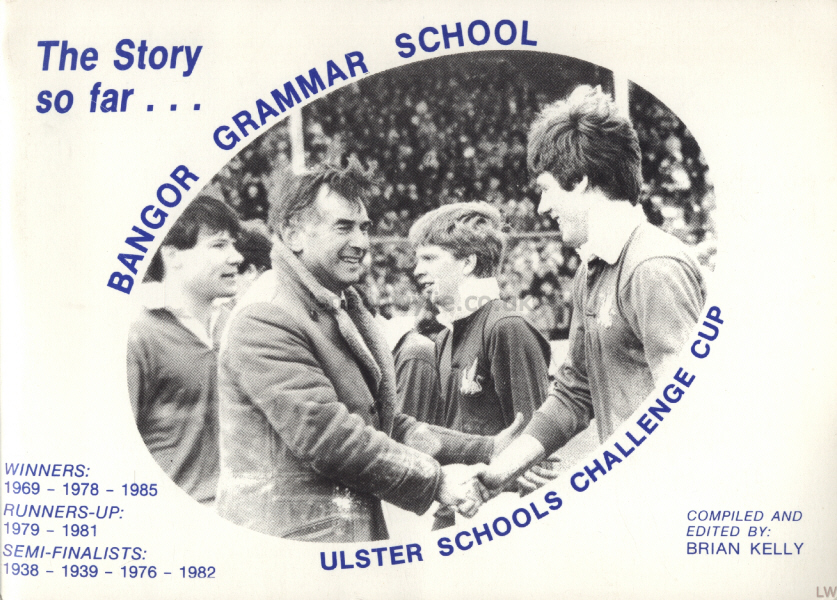
Bangor Grammar School, The Story so far ... Compiled and Edited by Brian
Kelly

 
    
Foreword by Brian Kelly ~ The Story So Far

The Medallion Shield was brought to Bangor Grammar School for the first time
in its history in 1936:
Rear: Mr. J. M. Rawlings, L. Redman, R. Pedlow, R. McConnell, Mr. M.
Wilkins, M. Ferguson, B. Gray, C. Fidler, Mr. R. E. Russell
Sitting: J. Close, W. Barbour, H. Greer, W. Gaw, M. Young, E. Park, W.
Bingham
Front: S. Brown, F. Gault
       

One of the two sides which so narrowly failed to reach the final of the
Schools Cup in the late Thirties. This is the 1938 side with Hugh Greer in
the Ulster jersey.
       
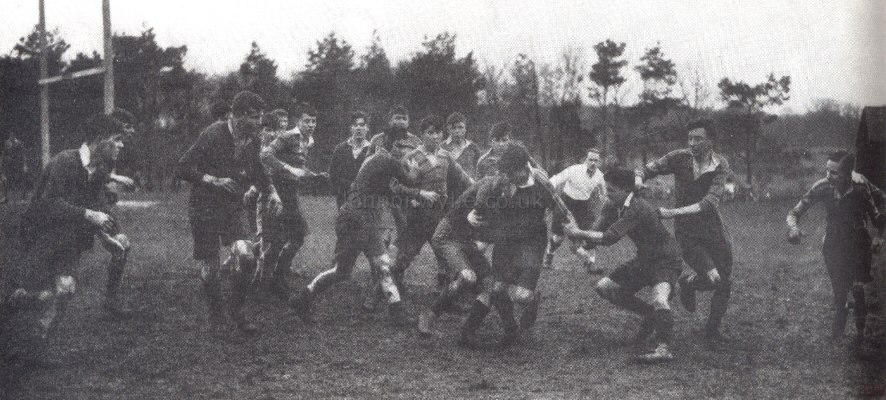
Action from a match in the late Thirties with Billy Gaw in the thick of
things as usual while Hugh Greer waits for the outcome.
       
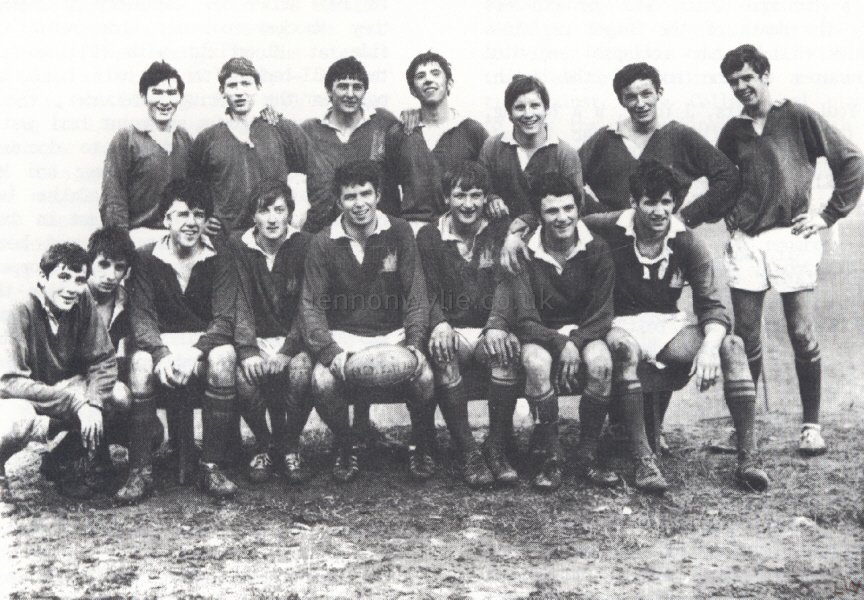
One of the keys to the success of the team in 1969 was that it was a settled
side. Here they are pictured after the semi-final victory over Coleraine.
       

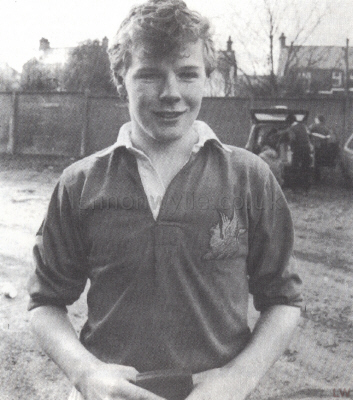
1
2
1) Dick Milliken, who went on to win Ulster, Irish and British Lions
honours, hands over the coveted Schools Cup trophy to an equally delighted
Headmaster Randall Clarke.
2) Mark McCall who kicked Bangor Grammar to the title last season has
already in 1985/86 season captained the Ulster and Irish Schools against the
touring Australians. He is undoubtedly a player of great potential.
       







1
2
3
4
5
6
7
1) Derek Larmour prepares to receive a pass in the 1978 Final ... but where
is the ball?
2) The successful 1978 team in joyful mood.
3) Kenny Hooks shows off the coveted trophy.
4) 1979 beaten Finalists
5) The Ulster Bank Schools Cup is the highlight of the season at Ravenhill
and is annually the best supported event at Ravenhill. Here at the 1981
Final one can see a section of the crowd.
6) a) Randall Jordan contests a line-out in the 1981 Final. b)
Flanker Robert McDowell recovers his senses after a knock during the 1981
Final as doctor Tim Smyth and coach Jim Welch look anxiously on. It was
while off the field that Ballymena scored their only try of the match.
7) 1981 beaten Finalists






1
2
3
4
5
6
1) A line-out from the 1985 Final between Bangor Grammar and Omagh Academy.
2) 1985 Final: Kenny Woods sets his three quarter line in operation.
3) This time it is Michael Webb who holds the Cup aloft to the ecstatic
Bangor Grammar supporters after the School had beaten Omagh Academy in the
Final.
4) The 1986 Squad pictured at a recent training session.
5) Successful Old Boys - Dick Milliken - Roger Clegg - David Morrow
6) Cup Winning Coaches - Matt Gillan - George Cameron - Jim Welch - Duncan
Macpherson - Dougie Rea
 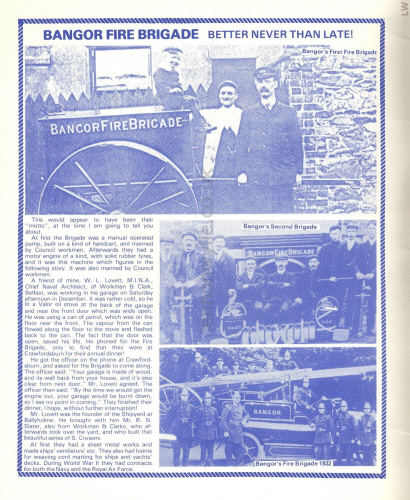
Bangor and Belfast Lough - Yesterday and Today
by Charles F. Milligan O.B.E.
Picture from chart published in 1691 to commemorate the landing of King
William at Carrickfergus in 1690
The 2nd Division Atlantic fleet at Bangor, 1907. (Picture presented to Royal
Belfast Golf Club by Rear Admiral G. E. Egerton)
The Sands at Ballyholme in the early 1900s before the Shipyard and the Yacht
Club cut channels in the outer rocks which held the sand. The groyns are
there today to bring the sand back.
Bangor's First Fire Brigade - Bangor's Second Brigade - Bangor's Fire
Brigade 1932










Index - The first regular Cross Channel Steamer "S.S. Eagle", Burns Line
to Glasgow - Bangor in 1800 - View from Parish Church tower before
1898. Present Northern Bank Building on right and in front of the bank the
Endowed School and Central Avenue - Church Street 1865 showing Bangor Abbey
Church also on right an old Public House there at the time - Upper Main
Street about the year 1896/1897 - Long Car Bangor/Donaghadee Service about
1898 - Bangor Grammar School - The Bangor Endowed School as it was in
1901 when the Council bought it for £1200 - Bangor Harbour in the 1890s -
The "PS Slieve Donard" owned by County Down Railway Co. with her sister ship
"Slieve Bernard" which plied Belfast to Bangor from 1900 up to World War 1
when they were mine sweeping - Vessels alongside Donegal Quay, 1880/1890s -
Old-Timers (Queen's Quay in the Nineties) - Schooners discharging
coal at Queen's Quay, 1880/1890s - The "Result" The Last Iron Ship Built
at Carrickfergus in 1893 - A Point of View - The Wreck of the Yacht "Urenia"
at Bangor on the 7th November 1890 and the loss of Viscount Cantelupe




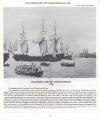



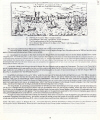

R.N.L.B. "George Pooley" stationed at Groomsport, 1880/90s - The
Night of the "Big Wind" - Ship ashore, Wilson's Point - The Big Wind 1894
- The J.M.K. of Arklow aground - The SS Appamm ashore at Smelt Mill Bay on
West Bay side of Bangor in 1933. Early coal boars had a difficulty when
light, because the bow stood up out of the water - Other Shipwrecks that
I Remember - Pickie with Channel Fleet in background about 1900 - The
French Fleet off Carrickfergus 1760 - The French at Carrickfergus -
Carrickfergus Castle as it is today - The Duke of Schomberg landed at
Bangor, Co. Down on Tuesday, 13th August 1689 - Picture from chart
published in 1691 to commemorate the landing of King William at
Carrickfergus in 1690 - Reduced facsimilie of first published chart of
Belfast Lough with soundings by Captain Greenville Collins, 1693 - ? - John
Paul Jones 'Ranger of Carrickfergus' left engaging H.M.S. Drake commanded by
Capt. Barden RN - John Paul Jones in Belfast Lough

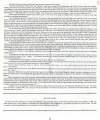


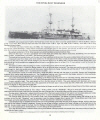





In Command of "Ranger" - Belfast Lough - High Street showing portion of
Old Dock about 1820 - Belfast Lough - Belfast Lough Tide Chart for
1st Hour of Ebb - The Royal Navy in Bangor - Bangor Amateur Swimming
Club - The high diving platform at Pickie Pool in the 1900s - Pickie in
the 1890s before the Marine Gardens, Seafront slopes and path to Stricklands
Glen were acquired by Act of Parliament - In 1891 derelict buildings and old
fishermens houses were demolished to make way for the new Seafront. The
McKee Clock and Putting Green and new shelter were added in 1915 -
Ballyholme and the West Side in 1890s before Kingsland was acquired in 1915.
The Yacht Club and Capronis and the Shipyard came early in the 1900s. The
Windmill was working up to the early 1900s - Where Have The Crowds Gone
Today? - Ballyholme Beach in the 1930s - One of the diving platforms
which should be removed to the East end of the Bay - The old Dufferin Villa
jetty - The Beginning of Modern Bangor - Bangor Didn't Wait For The
Planners - The Royal Ulster Yacht Club - This magnificent Club House was
built in 1890









The Royal Ulster Regatta 1896 - Regatta Programme front cover -
Belfast News Letter report of Saturday 18th July 1896 - The "Meteor" -
Other large yachts that raced at R.U.Y.C. in the period up to World War 1.
From right to left were the schooner "Westward", "Brunhilda" and also "The
Bona" which raced from 1907 to 1911 - Britannia Cut rating 96.8 H.R.H. The
Prince of Wales, R.Y.S. - The Bangor Corinthian Sailing Club - Bangor's
First Hospital 1869 - Beside the Library are three brick houses which
were built in 1869 as Bangor's Cottage Hospital. This hospital was to
supplement the service given by the Dispensary in Catherine Place (now
Dufferin Avenue) - Class 1 Belfast one design in 1898 -Belfast Lough Class
Yachts - Island Class Yachts Names from left to right: 1 Eriska, E. Workman;
7 Valia George C. Lepper; 2 Tiara, W. Hume; 6 Transnagh, Col. Sharman
Crawford; 4 Iviza, Wm. Mullan - The R.N.I.Y.C. Fairy Class First Raced
1902, still going strong - Regatta Day at Ballyholme Early 1930s - Lakes,
a joint Class for R.N.I.Y.C. and Ballyholme 1945 - Lakes racing at Bangor in
1943 - The Lake Class fin keel, Built in Dublin - The Cricket at Ballyholme
Sailing Club - Sir Thomas Lipton on "Shamrock" at Bangor. The local pilot
Charlie Scott left and Captain Sycamore at wheel. Lipton contested the
America Cup five times through the Royal Ulster Yacht Club - Shamrock 1
1899, shamrock II 1901, Shamrock III 1903, Shamrock IV 1920, V. J. Class
1920 - The Ballyholme Sailing Club Founded in 1900




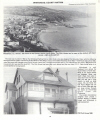




Ballyholme Bay - Ballyholme Bay Class at the start
of a race - View taken at Ballyholme Yacht Club in 1969 - In 1970 Bangor
held what was to be the last Irish Yachting Association Dinghy Weeks in July
20th to 24th 1970 - Dinghy Week 1970 - Philips World Championship 1979 -
The Royal North of Ireland Yacht Club - Whitehead, Co. Antrim, the home
of the County Antrim yacht clubs. The Club House can be seen at the bottom
left hand corner - right at the seafront - Old Club House 1909 - Strangford
Lough Yachting Centre at Whiterock as it is today showing anchorage and
yacht club - Betsy Grey's Cottage at Six Road Ends - Groomsport Harbour
- The Windmill at Ballyholme - Bangor Harbour and Seafront is Important -
Bangor Seafront as it is now
the end
|